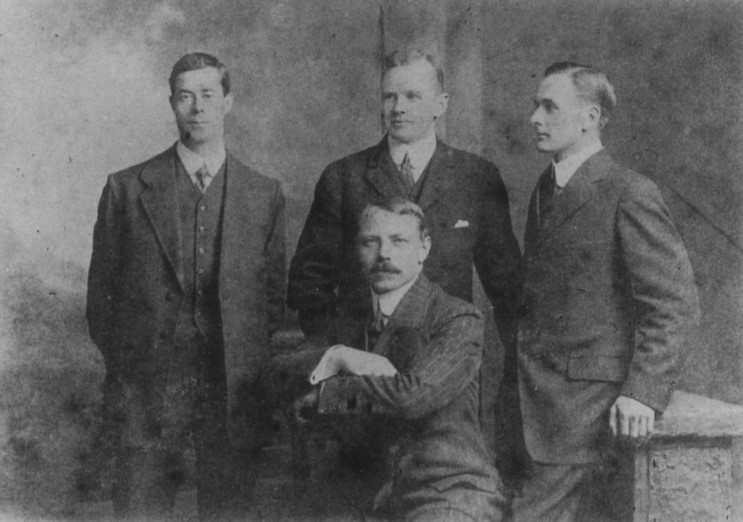Titanic (1912) |
|
Commander
Harold Godfrey Lowe, RD, RNR (1882-1944) |
 |
Titanic's surviving officers from left to right: Fifth Officer Harold G. Lowe, Second Officer Charles H. Lightoller,
|
Harold Godfrey Lowe was born Nov. 21, 1882 in Eglwys Rhos, Caernarfonshire, North Wales on Nov. 21, 1882, and ran away from home to go to sea at age 14, refusing the offer of an apprenticeship from his father. Lowe started as a Ship's Boy aboard the Welsh coastal schooners as he worked to attain his certifications. In 1906, he passed his certification and gained his Second Mate's certificate, then in 1908, he attained his First Mate's certificate. By the time he started with the White Star Line, in 1911, he had gained his Master's certificate and, in his own words, "experience with pretty well every ship afloat - the different classes of ships afloat - from the schooner to the square-rigged sailing vessel, and from that to steamships, and of all sizes." He served as Third Officer on White Star's the Belgic and the Tropic before being transferred to the Titanic as Fifth Officer in 1912. Despite his numerous years at sea, however, the maiden voyage of the Titanic was to be his first transatlantic crossing. Like the ship's other junior officers, Lowe reported to White Star's Liverpool offices at nine o'clock in the morning on 26 March 1912, and travelled to board Titanic at Belfast the following day. On sailing day (10 April), Lowe assisted (among other things) in the lowering of two of the starboard lifeboats to satisfy the Board of Trade that Titanic met safety regulations. When Titanic departed Southampton at noon, Lowe was on the bridge, relaying messages to various parts of the ship by telephone. On 14 April 1912, the night of the sinking, Lowe had been relieved at 8.00 PM by Sixth Officer Moody and was asleep in his quarters when the ship hit the iceberg at 11.40 PM. He remained asleep through the collision and did not wake up until as much as a half hour had passed; as he explained later, "We officers do not have any too much sleep, and therefore when we sleep, we die." When Lowe finally awakened and realized the situation, he immediately got dressed, grabbed his revolver, and went to work. Third Officer Pitman charged him with loading lifeboat No. 5. While assisting in the lowering of this boat, Lowe had a brush with White Star owner J. Bruce Ismay, who was manically urging him to hurry. "If you will get the hell out of that then I shall be able to do something!" Lowe responded. "Do you want me to lower away quickly? You will have me drown the whole lot of them!" Around 1.30 AM, Lowe engaged in a conversation with Sixth Officer Moody: While launching lifeboat Nos. 14 and 16 on the port side of the ship, the two junior officers felt that this group of boats needed to have an officer with them. Moody insisted that Lowe should get onto lifeboat No. 14 and that he would get on another one. By the time lifeboat 14 was being launched, things were beginning to get precarious on the boat deck as the majority of passengers began to realize that the giant ship was foundering. As lifeboat 14 was descending, Lowe used his revolver to fire three shots between the side of the boat and the side of the ship in order to frighten away a group of men attempting to leap into the lifeboat. After reaching the water, Lowe ordered his lifeboat to be rowed about 150 yards away from the Titanic. When the ship foundered at around 2.20 AM, Lowe had begun to gather several lifeboats together. He wished to return to pick up survivors but had fears of being swamped by hordes of people. Reluctantly, he waited until the screams died down before returning. When he returned to gather survivors, he picked up only four men, one of whom died later that night. Lowe's was the only boat to return for survivors. After that, Lowe had his crew of men ship the mast (he was the only officer to make use of the mast and sail in each lifeboat); using a breeze that had sprung up, he continued on to rescue the passengers on the sinking Collapsible A. Lowe and his group of lifeboats were picked up the next morning by the RMS Carpathia. An image taken by a passenger on the Carpathia clearly shows Lowe at the tiller of lifeboat 14 as they approach rescue. He remained aboard his lifeboat long enough to ship the mast and make certain everything was properly stowed. The Titanic survivors arrived at Pier 54 in New York on 18 April. Lowe was soon called upon to testify in the American inquiry into the sinking. He boarded the Adriatic on 2 May to return to England , where he participated in the British inquiry. Lowe's testimony in the American Senate Hearing was direct, often to the point of being flippant; when asked what an iceberg was composed of, Lowe responded, "Ice, I suppose, sir." Lowe also came under some fire for racist remarks. He had to apologize for twice using the word "Italian" as a sort of synonym for "coward." After returning home, Lowe married Ellen Marion Whitehouse in September of 1913. They had two children together: Florence Josephine Edge Lowe and Harold William George Lowe. Lowe went on to serve in the Royal Naval Reserve during World War I, attaining the rank of Commander before retiring to Deganwy with his family. He died of hypertension on 12 May 1944 at the age of 61 and was buried at the Llandrillo-yn-Rhos church in Rhos-on-Sea, North Wales. |
(Text courtesy of Wikipedia)
|
Page published Dec. 2, 2007 |